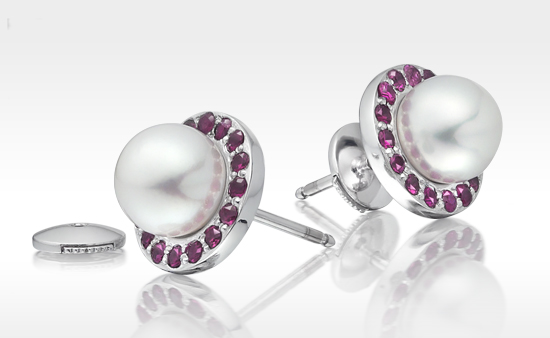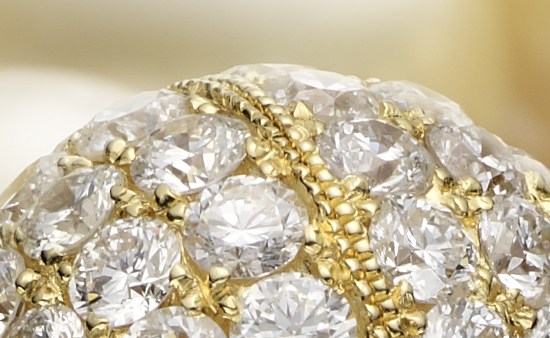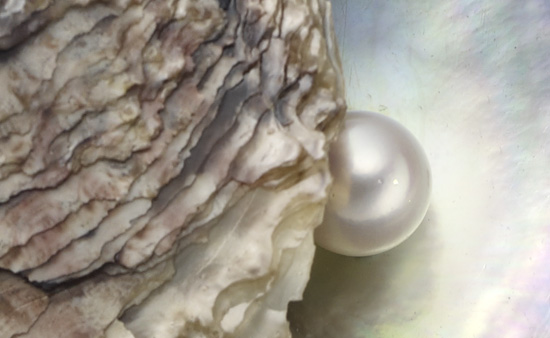Tagged with 'Gems'


-
A Royal Celebration of Diamond Jewellery
A Royal Celebration of Diamond Jewellery
Diamond jewellery lovers planning to visit London this summer should make a note to visit this year's annual Summer Opening of the State Rooms at Buckingham Palace.
Following on from last year's spectacular exhibition of exquisite Fabergé eggs and other objects, a new exhibition "Diamonds: A Jubilee Celebration" will showcase diamond jewellery from the royal collections spanning from over three centuries. The centrepiece of the exhibition is the Cullinan Diamond, a copy of which is pictured above, the most famous and largest diamond ever found.
The Cullinan Diamond was discovered in 1905 in South Africa and was presented to King Edward VII by the Transvaal Government. Weighing around 3,105 metric carats before being cut into a number of smaller diamonds, the Cullinan diamond remains the largest rough diamond ever found. It was insured for $1.25m before being discreetly sent to England in a plain box by registered post so as to outwit any interested thieves.
The difficult and precise task of cutting of the stone was performed by famed diamond expert Joseph Asscher in Amsterdam, who unfairly is said to have fainted when his first attempt at cleaving the stone failed and the blade broke. With new tools the Cullinan was finally split and then cut and polished into 9 principal diamonds named Cullinan I-IX and 96 smaller brilliant cut diamonds.
Cullinan I and II, also known as the First and Second Star of Africa, were respectively set in the Sovereign's Royal Sceptre and the band of the Imperial State Crown worn at the Queen's coronation.
Together as the centrepieces of the Crown Jewels, they are two of the most famous diamonds in the world and can be seen by visitors at the Tower of London's new display of Crown Jewels. The remaining seven diamonds Cullinan III-IX were set into a variety of brooches, rings and a pendant for Queen Mary, wife of George V, and are being displayed together for the first time in this new exhibition of royal diamond jewellery.
"Diamonds: A Jubilee Celebration" opens on 30th June and runs through to 7th October 2012. Admission is only possible as part of the entry to the State Rooms at the Palace, which includes the Throne Room, the Ballroom and other state reception rooms. Be sure to book early as admission does usually sell out at least several days in advance and interest this year, with the Queen's Jubilee and the Olympics, will be particularly high.
-
Diamonds (and Pearls) Are Forever!
Diamonds (and Pearls) Are Forever!
One of the classic gemstone combinations for jewellery designers is the contrast between the striking sparkle of diamonds and the soft, silky lustre of a pearl. How and when did our love of this beautiful pairing come about?
La Belle Époque from the late 19th century to the start of World War I was an era of opulence. It was a prosperous period that created wealth and the newly rich were keen to display their social status, enjoying a wave of sumptuous fashion and luxury jewellery.
The Edwardian trend was for slimming and elegant silhouettes with high collars that extended the neckline, corsets that showed off S-curved bodylines and tall hats with extravagant feathers. In response jewellers created delicate garland-style jewellery that appeared as if it were embroidery, with characteristic motifs of swags, ribbons, bows and flowers.
Before the late 19th century, European jewellers had looked to India and Brazil for their source of diamonds. Following the discovery of large diamond deposits in South Africa, however, and the set up and purchase of small mining operations by the company De Beers, the availability of diamonds changed forever. Platinum and diamonds began to be used widely by La Belle Époque jewellery designers to create intricate and gorgeous diamond necklaces with sparkling collars.
The grandeur of La Belle Époque ended abruptly with the dark reality of World War I.
Diamonds resisted the sombre times by reinventing themselves with new designs and sharing the fashion spotlight with other gems such as cultured pearls, which were new and taking the European jewellery markets by storm. Royal and society ladies matched diamond bandeaux and tiaras with long pearl necklaces. Coco Chanel created the Little Black Dress in the 1920s that she accessorised with a string of pearls. The simplicity of that dress with the elegance and beauty of pearls appealed to middle class and high society women alike throughout the 1930s and still resonates today.
With our lasting love of diamonds, De Beers famously grew to become the world’s largest producer of diamonds and coined the memorable slogan “diamonds are forever”. A diamond today is the traditional choice of engagement gift, a celebration present for a 10th or 60th wedding anniversary and is the birthstone for April.
View our jewellery collection of Diamonds and Pearls here.
-
Tsavorite Garnet - the new Emerald?
Tsavorite Garnet - the new Emerald?
Tsavorite garnets are beautiful gemstones with colours that range from a vivid, young radiant green to rich deep bluish green. As their name implies, tsavorites belong to the grossular garnet group of gemstones. The garnet is traditionally regarded as a symbol of friendship and is the birthstone for January.
Tsavorite garnets are famed for their brilliance. Even though cut tsavorites are rarely larger than two carats in size, their eye-catching radiance makes them highly desirable gems. Today they are mined in the stunning landscapes of East Africa from small deposits that were created millions of years ago. The ancient rock beds there have undergone tremendous forces, which have formed, shaped and shattered these collectable gemstones.
In comparison to green emeralds, tsavorite garnets are less well known despite being more rare and having some favourable properties for setting in jewellery. There may be several explanations for this, but one simple reason is that tsavorites were discovered just 50 years ago.
The discovery of tsavorite garnets is credited to Scottish geologist Campbell Bridges. Campbell Bridges first encountered rocks that contained small green crystals in Zimbabwe in 1960 and later in northern Tanzania close to Mount Kilimanjaro in 1967. Moving to Kenya after the nationalization of his mines in Tanzania in the 1970s, the pursuit of the tsavorite was an audacious endeavour. Campbell Bridges is said to have initially lived in a tree house to hide from wild animals and to have protected his precious gemstones from thieves with pythons.
Soon after Campbell Bridges’ discovery, Henry Platt, the then President of Tiffany & Co., expressed interest in this beautiful green gemstone. Together in 1973 they named the gem “tsavorite” in honour of the Tsavo National Park and Tsavo River in Kenya. In 1974 Tiffany & Co. led a campaign to introduce and promote tsavorites in the United States and later internationally. Tragically, Campbell Bridges died in a gang attack over mining rights in Southern Kenya in 2009.
The tsavorite garnet is one of the few gemstones that is wholly natural, without heat, radiation or oil treatments being used to enhance its colour or clarity. It is a romantic gemstone with a wild and untamed beauty. If you are seduced by the tsavorite’s brilliance, why not discover its radiant colour in Sophie Breitmeyer’s pearl jewellery collection for Winterson.
-
Sophie Breitmeyer for Winterson
Sophie Breitmeyer for Winterson
Some exciting news today of our first collection of designer jewellery!
Winterson, the online luxury brand specialising in pearl jewellery, and Sophie Breitmeyer, the award-winning young British jewellery designer, announce the launch of a colourful new collection of contemporary pearl earrings and pendants for 2011/12. The unique collection brings together two key trends with the combination of vibrant block gemstone colours and classic pearls.
Sophie Breitmeyer, a graduate of Central St Martins, was recently described by Vogue Italia as "a new talent to watch" and was previously a winner of the Bright Young Gems award in 2010. Since graduating, she has developed a strong following for her creative approach to design and her combinations of unusual stones and different coloured golds. Sophie recently collaborated on a catwalk collection with design duo Fyodor Golan, winners of the Fashion Fringe award at London Fashion Week this September, and has worked with Amber Le Bon on her collections.
The collection for Winterson is designed to be highly wearable for the daytime and for the evening. Three new jewellery designs for a pearl stud earring, a pearl drop earring and a pearl pendant combine colourful circles of gemstones such as pink rubies, blue sapphires and green tsavorite garnets to create nine individual pieces.
At the centre of each design is a classic Akoya Pearl, a white saltwater pearl that was one of the very first pearls to be cultured in Japan and is widely admired for its quality and lustre. The pearls are hand selected by Winterson for this collection, which is finished in 18 carat white gold and manufactured to the highest standards in Britain.
Starting at retail prices from £945, this new collection designed by Sophie Breitmeyer is exclusively available today from Winterson online.
-
Emeralds To Desire And Envy
Emeralds To Desire And Envy
A vivid and sumptuous green colour can be joyful and inspiring and it is no surprise that shimmering green emeralds are such sought after precious gems.
Columbia is one of the main producers of emeralds today, but the first emerald mines were located in Egypt dating from at least 3300BC. Cleopatra, Queen of Egypt, was famed for loving and wearing emeralds and, in ancient Egypt, it was customary for emeralds to be placed around the neck of mummies as a symbol of eternal youth.
The Duke of Devonshire Emerald is perhaps the most famous uncut emerald for being amongst the largest, weighing 1,383.93 carats and measuring about 5 cm square. Originally from the Muzo mines in Columbia, it was given to the sixth Duke of Devonshire by Dom Pedro I, the Emperor of Brazil when he came to Europe following his abdication in 1831. This incredible gem is displayed in The Vault in the Natural History Museum in London.
Brought to Europe by the conquistadors that invaded the Americas, emeralds have been beautifully used by designers as the centrepiece of outstanding luxury jewellery. The green of this precious gem, when matched with radiant pearls, will create the prettiest, irresistible pearl earrings and pendants.
The birthstone for the month of May, and the anniversary gift for both a 20th and 35th wedding anniversary, these really are gems to envy.
-
Sapphires Sing The Blues
Sapphires Sing The Blues
The striking blue of sapphires is quite mesmerizing, evoking the colours of both the sky and the sea.
Sapphires belong to the same species as red rubies, sharing the aluminium oxide mineral called corundum. Blue is the most popular colour of sapphires, but this elegant gemstone also comes in a variety of fancy colours including yellow, orange, green, brown and black. With pink and purple sapphires, the difference when compared to rubies starts to become a matter of debate for gemologists.
Sapphires have long been loved by kings and queens.
If you plan to visit the British Crown Jewels at the Tower of London, you will be fortunate to see the famous Stuart Sapphire. It is a beautiful blue gem that was mounted in Queen Victoria’s State Crown before eventually being replaced by the Star of Africa Diamond. Today the Stuart Sapphire is set at the rear of the British Imperial State Crown.
One of the most iconic royal sapphires of recent times is the blue sapphire on the ring that Princess Diana received for her engagement to Prince Charles in 1981. After Prince William also gave the same ring to Kate Middleton in 2011, this oval shape blue sapphire surrounded by a cluster of diamonds has generated an industry of imitations.
The rich blue color of sapphires marries beautifully with the lustrous shine of pearls. Princess Diana, for example, chose to set the blue sapphire and diamond brooch that was given to her on her wedding by Queen Elizabeth into the centrepiece of a stunning pearl choker necklace.
Worn for good luck, sapphires are the birthstone for September. What better way is there to greet the Autumn blues ?
-
All About Rubies
All About Rubies
Red has long been a symbol of passion and love. The word ruby is derived from the word ‘ruber’ in Latin, meaning red. It is no surprise that the ruby is able to seduce so many jewellery designers and jewellery lovers alike.
Rubies, together with sapphires, are precious stones that belong to the corundum mineral species, which are minerals composed of aluminium oxide.
These gemstones are found in a spectrum of deep vivid red to lighter pretty pink, caused by the element chromium. The beautiful colours of this gem are a wonderful match for the lustrous qualities of pearls, creating magnificent pearl jewellery that includes pearl earrings and pearl pendants.

Natural rubies are found mainly in Thailand, Afghanistan, Kenya, Madagascar, Myanmar (Burma), Tanzania, and Vietnam. Since 2008 all trade in Burmese rubies, admired for their deep blood-red colour, has been embargoed by the US and the EU.
One of the hardest gems, all natural rubies have imperfections, possibly containing mineral inclusions that give rise to a silky shine. Gemologists use these inclusions to distinguish rubies from imitation synthetic products. Large fine quality rubies are very rare and are amongst the most valuable of gems.
Rubies are renowned also for displaying a star effect called an asterism. In relatively rare instances, a sharp six-ray star forms when light is reflected by inclusions in the precious stone. Ruby stars are truly beautiful.
If you are lucky to be born in July, then ruby is your birthstone. Traditionally ruby jewellery is also the gemstone given for celebrating a 40th Wedding Anniversary. Wearing ruby jewellery is believed to bring health, wealth, wisdom and success in love.
-
Are Pearls Precious Or Semi-Precious Gems?
Are Pearls Precious Or Semi-Precious Gems?
This beautiful piece of jewellery was made during the Ming Dynasty in China (1368-1644), using pearls, rubies and other precious gemstones.
Historically, pearls have been one of the most revered of gems, but is the pearl also regarded as a precious gem?
ANCIENT PRECIOUS GEMSTONES
The origin of the term "precious gemstone" is believed to date back to ancient Egypt, Greece and Rome. There were five Cardinal gems, including diamond, ruby, sapphire, emerald and amethyst, which were revered for their rarity, value and religious significance.
Until the 18th century amethyst was considered a precious gemstone until vast natural deposits were discovered in Brazil and the value of this regally purple gem declined.

Today, only diamonds, rubies, sapphires and emeralds tend to be regarded as precious gems. All other colourful gemstones are usually described as semi-precious.
BY DEFINITION TODAY
What factors today determines whether a gemstone is regarded as precious or semi precious? Is it the composition of the stone, how well it has been cut or its rarity?
CIBJO, the World Jewellery Confederation, is the organisation responsible for creating a definitive set of standards for the grading, methodology and terminology of diamonds, coloured gemstones, pearls and precious metals.
CIBJO define a precious gemstone as a "natural inorganic material, with the exception of metals, used in jewellery". They also suggest that the term semi-precious, used widely to describe gems that are not a rare stone, is now "misleading".
THE QUEEN OF GEMS

What does this modern definition mean for the pearl?
Almost all gemstones can be defined as precious it seems, except perhaps the pearl for it is also formed with organic matter rather than inorganic material. An organic protein called conchiolin is an essential part of the substance that forms a pearls's nacre.
Natural and cultured pearls are then really quite unique in the world of gemmology.
Perhaps that is why the pearl is also known as "the queen of gems and the gem of queens".
If you are wondering how to choose between different types of pearls or their qualities, read our Buying Guide here.
-
Diamonds and Pearls - A Girl's Best Friends
Diamonds and Pearls - A Girl's Best Friends
Jewellers have worked with diamonds and pearls for hundreds of years and even today this is an adored combination of gems.
There is an astonishing choice of gemstones available to designers, including precious stones such as sapphires, emeralds and rubies, and semi-precious stones such as amethyst, topaz and peridot, so why is it that diamonds and pearls continue to be two of a girl’s best friends?
Diamonds have a remarkable appearance. They appear pure, translucid, nearly colourless and reflect incredible sparkles of light. Pearls are made with an equally exquisite material called nacre. They appear silky to the touch and smooth with a dazzling iridescence and overtones of colour. The unique synergy of diamonds and pearls creates a captivating elegance that is quite unrivalled.
Depending on the culture and the period in time, there are many traditional symbols associated with the matching of diamonds with pearls. Diamonds represent strength, purity, love and eternity, whilst pearls are symbols of good luck, chastity, innocence and friendship. With this symbolic history, it is easy to understand why diamonds and pearls are a perfect choice for bridal jewellery or wedding .
A white Freshwater pearl necklace can also be finished with a clasp set with diamond pave, and is versatile enough to be worn either for evening or business occasions. For a more relaxed every day look, pearl pendants and earrings can be mounted with sparkling diamonds for a twist of glamour.
If you love this combination of gems, view a selection from our Diamonds and Pearls collection.